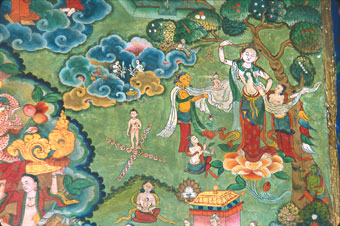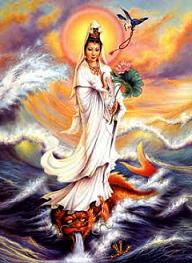THE ROLE OF WOMEN IN BUDDHIST MYTH
 Women are well represented in Buddhist myth, but they did not come by their status automatically. The Buddha and his early followers were skeptical about the ability of women to attain enlightenment, but the women were equally persistent.
Women are well represented in Buddhist myth, but they did not come by their status automatically. The Buddha and his early followers were skeptical about the ability of women to attain enlightenment, but the women were equally persistent.
The Buddha’s mother, Queen Mayadevi of Nepal, played a relatively passive role. She dreamed that a white elephant descended from heaven and entered her womb. The elephant told her that she had conceived a pure and powerful child. An earthquake followed, as well as thirty-two other signs.
When she gave birth, the queen experienced a ecstatic vision while the gods Brahma and Indra took the child painlessly from her side and offered him ritual ablutions. She died shortly afterward, leaving her son for her sister to raise.
Not all females in Buddhist myth are benign. When Mara, ruler of desire and death and the personification of evil, tried to tempt the Buddha away from his meditation, he sent his three daughters Tanha (desire), Raga (lust) and Arati (aversion) to seduce him.
After the Buddha became enlightened, Bhikshuni Mahaprajapati Gautama, the aunt who raised him, asked to join his monastic order. The Buddha did not think women would be able to handle the ascetic life style. Mahaprajapati gathered a large group of women and asked to establish a parallel order of nuns. Her persistence won the Buddha’s agreement. The female order was exclusively under the control of the women, with no male direction. The Buddha’s aunt was the first Buddhist nun to be ordained, and the founding mother of the order. The foremost scholars, known as the “twelve women apostles”, became saints, with specialties such as wisdom, miracles, holiness, clairvoyance, missionary work, diligence, and remembering past lives.
In Buddhist traditions, goddesses are generally forged through a number of reincarnations, ascending from ordinary human beings through their lives of virtue and sacrifice. Gender-shifting can occur during this process. One of the most popular of all Buddhist goddesses, the Chinese goddess of mercy, Quan Yin (“Born of the Lotus”), was male until the early part of the 12th century. Her prototype, Avalokiteshvara, was at the gate of Paradise when he heard a cry from the earth, and chose to remain there to bring relief to suffering. A similar story is told of Quan Yin. She is very receptive to prayers, and even cares for souls in the underworld. She is a tall, slender, graceful figure, the epitome of Chinese beauty.

In one ancient legend her name was Miao Shan, the daughter of an Indian prince. When she had attained buddhahood, she visited her blind father in disguise, and told him that he could be healed if he would swallow the eyeball of one of his children. When none of the children agreed to make the necessary donation, Miao Shan created an eye which allowed her parent to regain his sight. She then persuaded him to join the Buddhist priesthood.
Hariti (“The Snatcher”) began her career in India as a demon goddess of smallpox. Through the influence of the Buddha, who showed her the suffering she caused, Hariti became the goddess and protectrix of children, as well as women in childbirth. Midwives call themselves “daughters of Hariti”. Her cult spread to China and Japan. Her conversion may be a reflection of shifting dynamic of authority and gender in early Buddhist traditions.
Bodhisattva Tara, the symbol of Enlightened Womanhood, began her life as a princess. A monk advised her that she should pray to be reincarnated in a male body so that she could become enlightened and help others. She vowed to attain enlightenment as a woman, and prayed to be always reborn as a woman. She is most commonly represented as white or green in color. She has evolved to goddess status, and her worship is popular in Nepal, Tibet, China, and Japan.
Kalasiddu of Nepal was the daughter of weavers. When her mother died in a famine, Kalsiddhi was abandoned with her mother’s body at the cremation ground. A woman Yogini found her baby, raised her, and helped her attain enlightenment. Kalasiddhi passed the teaching on to a farmer’s son who became the great Master Vaijrahunkara.

Bikshuni Srimati, a Buddhist nun in India who founded the ascetic “Nyun-gne” tradition, was born into a royal family, but she refused to be forced into marriage. After she left her family to join a religious order, she contracted leprosy and had to life in the forest. Through meditation and prayer, her leprosy disappeared. She attained enlightenment and made many disciples.
These stories demonstrate that, although the road requires great self-sacrifice and dedication, usually through several lives, Buddhist women are just as able as men to reach the status of sage, saint, or even deity.
Sources and resources:
– Qyan Yin
By Christine G. Richardson[[ Learn more about this author, Christine G..
Click here to send author comments or questions.
]]
Source : Helium




